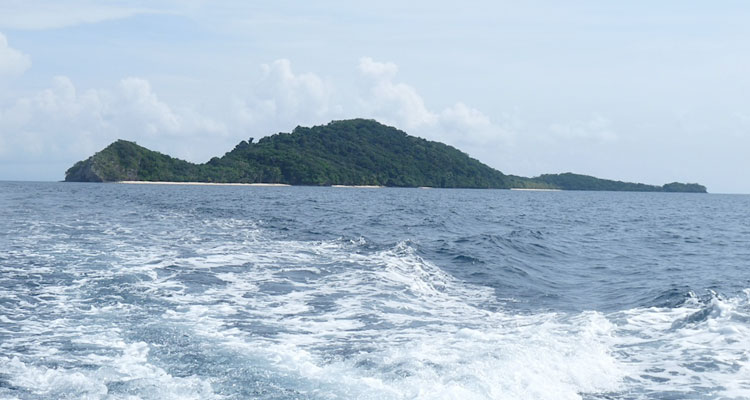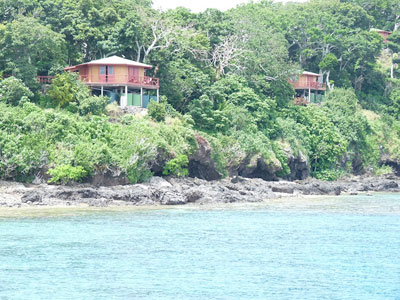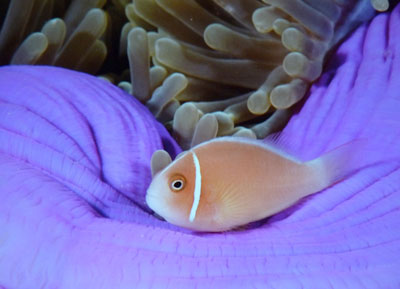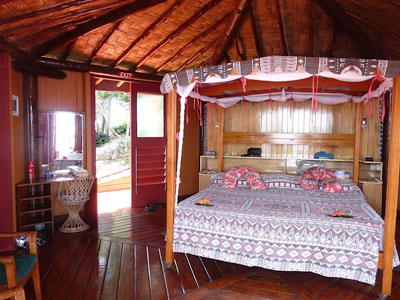Enjoying 10 days on a private Fijian island
by Linda & Peter Beuret, Santa Barbara, CA
For our 44th anniversary, my husband, Peter, and I decided we would like to snorkel in some clear, warm waters. A beautiful view with lots of time to read wouldn’t be bad either!
We had read about an island called Namena, 14 miles off Vanua Levu, one of the two major islands of Fiji. Back in 1983, Joan and Tom Moody, an American couple, took a 99-year lease on this uninhabited island and built their dream: a snorkel/dive resort with six hexagonal bures (cottages), plus their own private bure, a dining room, a kitchen, an office building and two buildings for 10 Fijian staff members, all situated on the hillsides of the island, each building hidden from the others by tropical jungle but connected by trails.
The island
Tom decided to develop only 10 of the island’s 110 acres, leaving the remainder in its virgin state. Shaped like a dragon, the island is roughly one mile long, and Tom has cleared a trail from “head to tail” that takes about an hour and a half to hike.
From most places on Namena you can look out at a turquoise reef, 10 minutes by motorboat from the dock, and on past deep-blue waters to the big island of Vanua Levu and the town of Savusavu. In 2004, Tom was able to get the Fijian government to declare the reef and its surroundings a marine park to assure that the crystal-clear waters and unspoiled coral reef remain that way for the future.
Getting there
To reach Namena, we flew out of Los Angeles at 9:30 p.m. on Air Pacific, landing in Nadi, Fiji, at 5 a.m. the next day. A connecting one-hour Air Pacific flight two hours later landed us in Savusavu, where we were met by two staff members in one of the resort’s two boats for the crossing to Moody’s Namena (phone +679 828 0577).
Once on the island, it was “Welcome to paradise!” We were shown to our bure by Kiri, a young Fijian woman who demonstrated how the four large sliding doors of the cottage leading out to the wraparound deck could be adjusted to allow the island breezes to flow through the room. The bure included “his and hers” bathrooms connected by a shower, the water heated by solar panels.
There is no electricity on the island, but four solar lights were bright enough to read by in the evenings, and solar flashlights got us to and from the dining room at night.
The food
All meals at Moody’s were announced 15 minutes in advance… by drum! Breakfasts were a delight, including platters of fresh fruit (mango, papaya, soursop, pineapple, finger bananas and passion fruit), eggs done to order and coconut-banana pancakes. Lunch always consisted of a homemade soup and a main dish, such as chicken salad, pizza, spaghetti, tacos or burgers.
Dinners were served family style on lazy Susans set in the center of six-person dining tables. Dinners featured local fish, chicken, steak, veggies grown on the island and homemade desserts. The food was outstanding. What Moody’s doesn’t grow in their garden is imported from Savusavu along with soft drinks, beer and wine.
Nigel, the manager, had e-mailed us with the suggestion to look in the well-stocked duty-free shop in Nadi’s airport if we wanted to buy spirits; the resort would provide the mixers. We hand carried a bottle of gin and a Barbados rum on the short flight to Savusvu, no questions asked.
Underwater adventure
Divers and snorkelers are given equal attention at Moody’s, and twice a day, at 9:30 and 1:30, the dive boat makes the 10-minute trip to various parts of the reef, dropping divers over the wall edge and leaving snorkelers on the shallow reef, both groups accompanied by staff who show them the wonders of the sea. And what wonders there were!
Peter and I have snorkeled some pretty great reefs — in Palau, the Solomon Islands and the Sulu Sea as well as the Great Barrier Reef — many from live-aboard dive boats, but none of those reefs surpassed the absolutely clear water and abundant colorful corals of Namena.
There were tropical fish in profusion in every color and type, including schools of Jacks, wrasses, sweetlips, bream and parrotfish. Smaller cromis, Moorish idols and rabbit-, butterfly-, angel- and bannerfish were everywhere, darting in and out of staghorn, mushroom, plate, brain and soft corals.
We are especially fond of trying to ID butterflyfish, and with the fish books in the main lounge we listed 23 species!
Another interest of ours is spotting anemones and the fish that live in them; we counted five species of these.
Staffers George and Gina usually were with us in the water, and they knew the different spots on the reef best for snorkelers. We all would be dropped off in one spot and would slowly work our way down the reef wall for about an hour. Then we would signal the boat to pick us up and run us back to the dock.
Other activities
Tom Moody (Joan passed away in 2010) has accumulated a very large library over the past almost 30 years, including an extensive collection of books on Churchill and travel adventure books from all over the world, as well as the “Girl with the Dragon Tattoo” books. I averaged a book a day.
Being bird-watchers, we brought our binoculars and a small book on the birds of Fiji. The islands are limited on species, but we saw a good variety, including the Vanikoro broadbill, orange-breasted honeyeater, white-tailed tropicbird and golden whistler.
The rarest bird, the buff-banded rail, turned out to be the easiest to see. A ground bird that is normally very shy and elusive, it lives on Namena with no predators. Therefore, it is completely unafraid, practically running across your shoes as you wander the trails.
Though snorkeling and reading comprised our days, there are many white-sand beaches for the sun worshipers, and individual kayaks are available for exploring the area. However, anyone looking for nightlife should not consider Moody’s. The staff is happy to organize a volleyball game with guests; otherwise, you must create your own amusement.
Moody’s has several packages for stays, ranging from the minimum five-night stay ($1,535 per person, twin share, plus 20% tax; add $300 for six scuba dives) to the “stay 10 nights pay eight” package ($2,230 per person, twin, plus tax; add $640 for 16 scuba dives), which is the package we chose. Everything except drinks is included in the price, from pickup in Savusavu to return to the airport. No children under 16 are allowed.
We visited Moody’s in early January ’11. The weather in Fiji is pretty constant year-round, with highs in the upper 80s and lows in the mid 70s. Their summer (December-February) is supposed to have some rain and winds, but we saw little of either.




